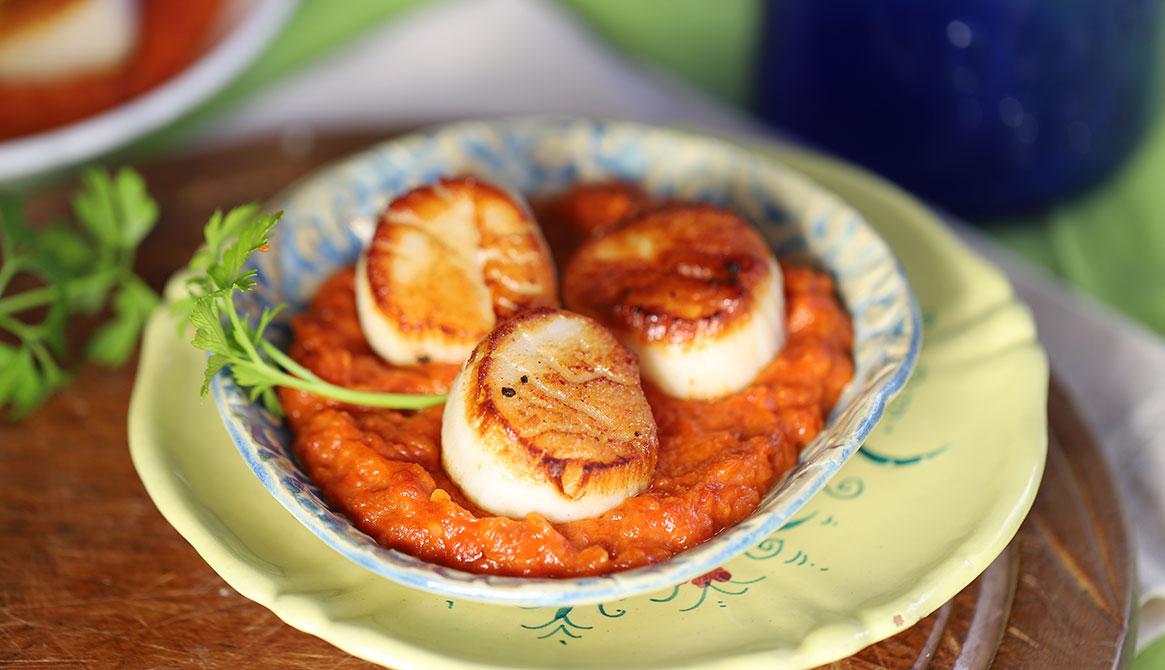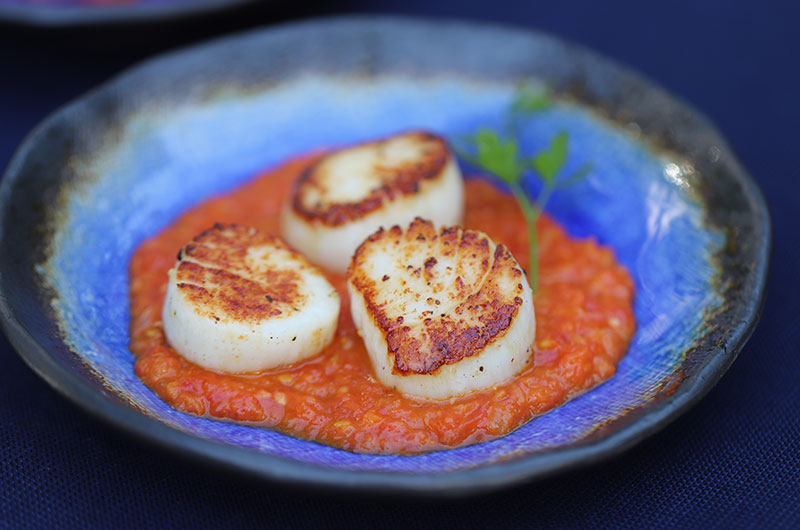Once you make the easy and delicious sauce for these seared scallops, I predict you’ll make it again and again. I grabbed the technique for preparing and reducing the tomatoes – grating them on a box grater and then simmering the pulp and juice with a bit of onions – from the traditional method of making a Spanish sofrito, the first step in making paella.
The delicious tomato essence is then mounted with very cold butter (a French technique) with a nod to Italian cooking maven Marcella Hazan, who loved to make tomato sauce with butter. The cold butter melts just enough to make the sauce creamy and to hold it together.
Once made, the sauce should be taken out of the pan right away (it will hold off the heat at room temperature for 20 or 30 minutes if need be). Just don’t reheat the sauce, which would cause the butter to break and the sauce to be oily. (It sounds more complicated than it is; it is truly easy and delicious.) (Photo of summer version at top of page.)
THE WINTER VERSION: This recipe is so simple and delicious that I recently decided to adapt it using canned crushed tomatoes so that I could make it in winter. The resulting sauce is a bit thicker than that made with fresh tomatoes, but still tasty. Scroll to the end of the recipe for directions using canned tomatoes.
This recipe makes enough for a first course for four people or a light main course for two people.
Serves 4 as a starter, 2 as a main
- 1 small onion
- 2 medium beefsteak tomatoes
- Kosher salt
- 2 tablespoons olive oil, more for searing scallops
- ½ teaspoon balsamic vinegar
- 2 tablespoons cold unsalted butter, cut into small pieces (and kept in the refrigerator until time to use)
- 12 large sea scallops, small side muscle removed
- Freshly ground pepper
- Parsley leaves or snipped chives.
1. Cut the onion in half (through the equator) and grate each half on the large holes of a box grater over a plate until you have a pile of pulp and you are left with just the onion ends.
2. Cut each tomato in half (through the equator) and over a separate rimmed plate or shallow bowl, grate the tomatoes until you are left with just the tomato skin and you have a dish of pulp and juices (seed are fine, too).
3. In a 10-inch nonstick skillet, heat the olive oil over medium low heat. Add the grated onion and a good pinch of salt. Cook, stirring, for 3 to 4 minutes, or until the onion is softened and translucent. Add all of the tomato pulp and juices, season with another pinch of salt, and cook, stirring, until the mixture has reduced and thickened (most of the liquid will be cooked off) and has turned a deeper, brick-red color, another 12 to 16 minutes. (You will have to adjust the heat to get the tomato mixture gently simmering to cook it down.)
4. Add the balsamic vinegar, stir, and reduce the heat to very low. Begin to add the cold butter a few pieces at a time, whisking the tomato mixture constantly but gently as the butter melts. Continue to add all of the cold butter, a little at a time, whisking each time, until all the butter has been incorporated and the tomato sauce is creamy. Remove the pan from the heat. If not using within the next few minutes, transfer the sauce to a plate or dish. Taste and season with a little bit more salt if necessary.
5. In a separate skillet big enough to hold all of the scallops, heat just enough olive oil to cover the bottom of the pan over medium heat. When the oil is hot, season one side of each scallop with salt and fresh pepper and add each to the pan, seasoned side down. Season the top side. Cook (without disturbing) for two minutes. (The scallops should be sizzling in the pan; if not, turn your heat up a bit). Using tongs, check the bottoms to see if each is nicely browned. If not, cook for 30 to 60 seconds more. Turn over and cook for 1 to 2 minutes more. Remove from the heat.
(Sea scallops vary in size so cooking times are hard to estimate, but err on the side of undercooking rather than overcooking. They firm up and turn white as they cook, but it’s perfectly fine for them to be still slightly pink in the middle. With practice on your stove with your pan, you can learn what your optimal cooking time is. The key, though, to extra flavor is the browning, so starting with a hot pan is important.)
6. Divide the tomato “butter” between four small plates, spooning it into a circle in the middle of the plate. Arrange three scallops on each plate. Garnish with parsley or chives and serve right away. (For two bigger servings, use just two plates and arrange six scallops on each.)
The Winter Version:

To make this recipe with canned tomatoes, substitute 1 cup canned crushed tomatoes for the pulp from the two fresh tomatoes.
Buy the best quality canned crushed tomatoes that you can. The canned tomatoes may thicken up a bit more quickly than the fresh tomato pulp. For that reason, you might want to lower the heat so that you can cook the tomatoes down for a bit longer. The longer they cook, the more chance they have of deepening in color and flavor. You'll still probably need only about 10 to 12 minutes.
The yield also may be slightly bigger with the canned tomatoes (still just about enough for 4 small appetizer servings), so the sauce could take up to 3 tablespoons of cold butter instead of 2 at the end.




 5 comments
5 comments


Comments (5)